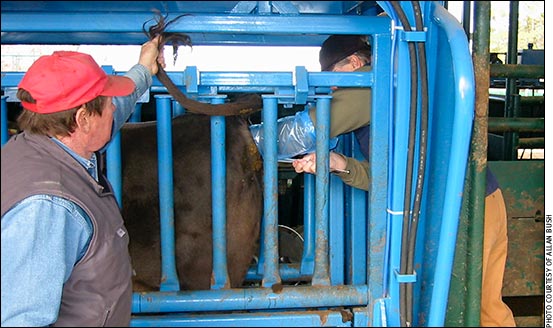HEALTH & NUTRITION...

Managing Heat Stress
As temperatures rise, producers may need to pay closer attention
to their synchronization programs.
Working cattle in hot weather can be detrimental to heat synchronization and artificial insemination (AI) programs, says Julie Walker, beef specialist for South Dakota State University (SDSU). When cattle need to be moved or worked, it pays to watch weather forecasts and try to choose a day that won’t be during a heat wave. Sometimes, however, producers need to get cattle in for a heat-synchronization program, and timing is crucial, regardless of the weather.
Walker says more producers are shifting to April-May calving to match forage with nutritional needs of the lactating cow and to reduce labor at calving to avoid having to worry about cold weather in February-March. Now, she says, they have to deal with the heat instead. Read more.
Rapid pH Drop Key to Quality Silage
Rapid silage pH drop sets the table for reduced clostridia, E. coli growth.
A rapid pH drop is the first requirement to produce quality silage. When pH doesn’t drop quickly, it allows other microbes like clostridia and E. coli to grow.
“Clostridia occur naturally in soils, and they get into field crops naturally at harvest,” says Bob Charley, forage products manager for Lallemand Animal Nutrition. “If clostridia get going, they use up sugars and lactic acid and convert them into butyric acid, which causes some serious feeding issues.”
As anaerobic microbes, clostridia will grow even in well-packed silage if the pH is above 5.0. However, clostridia can also occur in aerobically unstable silages, as growth of the aerobic spoilage organisms creates anaerobic zones.
Spoiled silage with an elevated pH can allow other microbes like E. coli O157:H7 to grow. E. coli O157:H7 is a major cause of foodborne disease. Reducing its numbers in cattle rations can help reduce the risk of foodborne illness. Read more.
New Mitigation Option for Heat Stress
Yeast supplementation may be another tool for heat mitigation.
Heat mitigation is an increasingly important issue, and there are several strategies at cattlemen’s disposal, especially in the feedlot. Shade, ration changes, changing feeding times, spraying or misting, and improving water availability are all tools within the toolbox, but morbidity and mortality continue to be a significant issue in U.S. feedlots. Heat stress has cost the industry at least $369 million, said Jeff Carroll, research leader in livestock issues research for USDA Agricultural Research Service (ARS) in Lubbock, Texas.
The Texas researcher spoke at the fifth International Symposium on Beef Cattle Welfare (ISBCW) in Manhattan, Kan., June 8-10. He shared that previous research indicated supplementing yeast products during a period of naturally occurring heat stress improved feed intake and gain without jeopardizing the health of the cattle. Read more.

Rick Rasby
Ridin’ Herd
Be ahead of the curve for opportunities this summer.
The ethanol industry produces a byproduct that fits well as a feed source for beef cows and in feeding programs where the base ration is forage. Even though some of the plants have removed some of the fat that was once used from distillers’ grains, it is still an excellent feed that can be used in diets of beef cows, in heifer development and in backgrounding cattle. Read more.
Leptospirosis
Cattle in areas with standing water most susceptible.
Leptospirosis in cattle occurs worldwide. Illness from this type of infection is usually mild (unless it causes renal damage), but this disease is sometimes economically significant because it can cause abortion.
“Lepto” is caused by spiral-shaped bacteria that affect many kinds of animals, including humans. It is often present in wildlife populations. The leptospires can survive in surface water, stagnant ponds, streams or moist soil for long periods at mild temperatures. It is thus more common in wet climates. Read more.
BCS Indicates Welfare Status
Body condition assessments can be used as an indicator of an animal’s welfare, as well as its nutritional status.
Most cow folk are familiar with the body condition scoring system of gauging the relative fatness of beef cows. Commonly used in the United States is a 9-point scale ranging from body condition score (BCS) 1, denoting severe emaciation, to BCS 9, representative of a very obese animal. The BCS system is widely recommended as a tool for assessing the nutritional status of a cow herd. However, Kansas State University (K-State) veterinarian Bob Larson believes it may also serve as a metric for beef cattle welfare.
A professor of clinical sciences at K-State’s college of veterinary medicine, Larson said a dam’s BCS is a relatively good tool for assessing the welfare of her calf. Cow body condition, particularly during the last trimester of gestation, influences calf birth weight, percentage of live calves at birth and weaning, and calf weaning weight. Cow body condition also influences the time needed to return to estrus and rebreed. Read more.
Rumen Acidosis
An animal welfare issue, rumen acidosis is not limited to cattle eating grain.
Rumen acidosis is a malady that many cattle-savvy people associate with grain overload. Acidosis is the likely outcome when a large quantity of grain is introduced to an unadapted ruminate digestive system. However, it can occur in animals grazing forages only, provided the forages contain highly soluble carbohydrates.
According to veterinarian and researcher Kelly Lechtenberg, acidosis can result from excessive ingestion of any feeds rich in fermentable components. While even grazing cattle can be affected, the owner of Midwest Veterinary Services and Central States Research Centre, at Oakland, Neb., said acidosis is more often a feedlot issue. Read more.
Cattle Diseases: Common Conditions/Terms
Click here for a list of common conditions and terms related to beef cattle diseases, such as anaplasmosis, brucellosis, BVD, E. coli, IBR and others.
[Click here to go to the top of the page.]






